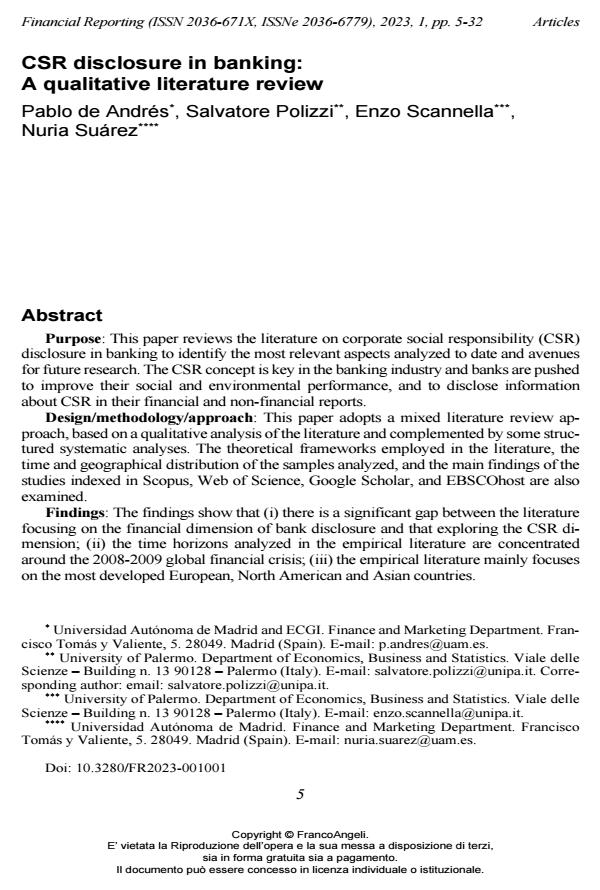CSR disclosure in banking: A qualitative literature review
Titolo Rivista FINANCIAL REPORTING
Autori/Curatori Pablo de Andrés, Salvatore Polizzi, Enzo Scannella, Nuria Suárez
Anno di pubblicazione 2023 Fascicolo 2023/1
Lingua Inglese Numero pagine 28 P. 5-32 Dimensione file 236 KB
DOI 10.3280/FR2023-001001
Il DOI è il codice a barre della proprietà intellettuale: per saperne di più
clicca qui
Qui sotto puoi vedere in anteprima la prima pagina di questo articolo.
Se questo articolo ti interessa, lo puoi acquistare (e scaricare in formato pdf) seguendo le facili indicazioni per acquistare il download credit. Acquista Download Credits per scaricare questo Articolo in formato PDF

FrancoAngeli è membro della Publishers International Linking Association, Inc (PILA)associazione indipendente e non profit per facilitare (attraverso i servizi tecnologici implementati da CrossRef.org) l’accesso degli studiosi ai contenuti digitali nelle pubblicazioni professionali e scientifiche
Purpose: This paper reviews the literature on corporate social responsibility (CSR) disclosure in banking to identify the most relevant aspects analyzed to date and avenues for future research. The CSR concept is key in the banking industry and banks are pushed to improve their social and environmental performance, and to disclose information about CSR in their financial and non-financial reports. Design/methodology/approach: This paper adopts a mixed literature review approach, based on a qualitative analysis of the literature and complemented by some structured systematic analyses. The theoretical frameworks employed in the literature, the time and geographical distribution of the samples analyzed, and the main findings of the studies indexed in Scopus, Web of Science, Google Scholar, and EBSCOhost are also examined. Findings: The findings show that (i) there is a significant gap between the liter-ature focusing on the financial dimension of bank disclosure and that exploring the CSR dimension; (ii) the time horizons analyzed in the empirical literature are concentrated around the 2008-2009 global financial crisis; (iii) the empirical litera-ture mainly focuses on the most developed European, North American and Asian countries. Originality/value: This study contributes to extant literature by describing the state of the art on CSR disclosure in banking and paving the way for future re-search on this topic. A call for research is raised on corruption-related disclosure and the relationship between national economic development and bank transpar-ency, with specific reference to CSR disclosure.
Parole chiave:disclosure, banking, corruption, CSR, corporate social responsibility.
Jel codes:G21, M14, M41
- The Readability of Non-Financial Information. The Role of Stakeholders' Pressure in the European Setting Alessandra Allini, Begona Giner, Marco Maffei, Annamaria Zampella, in Accounting in Europe /2025 pp.279
DOI: 10.1080/17449480.2024.2380312 - Revisiting the impact of ESG on financial performance: Empirical evidence from the Italian Stock Exchange Michele Bertoni, Paolo Candio, Paola Rossi, in FINANCIAL REPORTING 2/2024 pp.163
DOI: 10.3280/FR2024-002007 - Environmental reporting and religiosity: An empirical analysis within the European financial sector Simone Terzani, Teresa Turzo, Gianluca Moretti, in FINANCIAL REPORTING 1/2025 pp.117
DOI: 10.3280/fr202516716
Pablo de Andrés, Salvatore Polizzi, Enzo Scannella, Nuria Suárez, CSR disclosure in banking: A qualitative literature review in "FINANCIAL REPORTING" 1/2023, pp 5-32, DOI: 10.3280/FR2023-001001